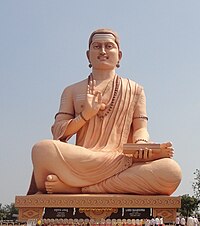Religion in Karnataka
Religion in Karnataka has played a very important role in shaping modern Indian religions and philosophy.
Hinduism
The three most important schools of

In the 12th century, social reforms emerged in northern Karnataka as a protest against the rigidity of the prevailing social and caste system. Leading figures of the movement such as Basava, Akka Mahadevi and Allama Prabhu established the Anubhava Mantapa where Lingayatism was expounded. Nearly 29% population of Karnataka belongs to Lingayat
Jainism

Buddhism
Culture
Karnataka played a very important role in shaping present day Indian religion and philosophy.
The great saint
Temples

The Empires and Kingdoms that came to rule from Karnataka were prolific builders. The
Islam
Islam, which had an early presence in the west coast of India as early as the 10th century gained a foothold in Karnataka with the arrival of the Bahmani Sultanate and Adil Shahi dynasty, which ruled parts of Karnataka.[7]

Islam arrived in Karnataka and Kerala in the 7th century with Arab merchants trading in spices. Muslims introduced coffee, and the paper industry to the local economy.
Muslims form approximately 12.91% of the population of Karnataka.[11] While Muslims can be found in all districts of Karnataka, Muslims have a stronger presence in:[12][13]
1. Northern Karnataka (especially in the area formerly ruled by the Princely State of Hyderabad) such as Gulbarga, Bidar, Bijapur, Raichur and Dharwad.
2. The districts bordering Kerala.
3. The cities of Bangalore, Mysore and Mangalore.[13]
In coastal Karnataka in particular, Muslims form 24% of the population, the double of their overall share in the state, belonging to the Beary community which is known to be involved in trade and business, having particularly profited from the mass immigration to the Gulf from the '70s onward, owning diverse malls, hospitals, construction and educational institutions in the region.[14]
On the other hand, the proportion of Muslims is lower in central Karnataka.
Christianity
This section needs additional citations for verification. (February 2023) |
Mangalore has the largest population of Roman Catholics as compared to other parts of Karnataka.[citation needed] They are mostly descended from Goan Catholics and Orthodox Christians who immigrated from Goa in the 17th and 18th centuries. There are also some Protestants found in Karnataka. Many of them are of local origin. Protestants are the result of British missionaries' work during the British empire in India. However the British conversion was voluntary and not compulsory as Portuguese was in most cases. Due to this the Protestants are fewer in number as compared to the Catholics. Bangalore has a large number of Catholics as well as Protestant people.
St. Mary's Basilica is the only basilica in Karnataka and the oldest church in Bangalore.
Footnotes
- ^ Census 2011 data
- ^ (Kamath 2001), p150-152
- Western Gangas(Altekar in Kamath 2001, p92)
- ^ The earliest cultivators of Kannada literature (Narasimhacrhaya 1988, p17
- ^ Kamat, Jyotsna Dr. "Buddhist System of Education". Education in Karnataka through the ages. Kamat's Potpourri. Retrieved 10 June 2007.
- Shaiva, Ramanujacharya came to Karnataka in 1098 and lived there till 1122 C.E. He first lived in Tondanur and then moved to Melukote where the Cheluvanarayana temple and a well organised Mathawere built. Hoysala Vishnuvardhana became his devotee and converted from Jainism to Hinduism. This helped popularise his Vishva adviata philosophy in the region, A Concise History of Karnataka, Dr. S.U. Kamath, A History of South India, From Prehistoric times to fall of Vijayanagar, by Prof. K.A. Nilakanta Sastri
- ^ Sastri (1955), p396
- ^ Encyclopaedia of India: Karnataka, Pran Nath Chopra (1992)
- ^ Muslim Wedding South India
- ^ Tipu Sultan Profile
- ^ Indian Census 2001 - Religion Archived 2007-03-12 at the Wayback Machine
- ^ a b A. R. Fatihi. "Urdu in Karnataka". Language in India, Volume 2: 2002-12-09. M. S. Thirumalai, Managing Editor, Language in India. Retrieved 29 June 2007.
- ^ a b Map of Muslims in India
- ^ Dhingra, Sanya (5 August 2022). "Why coastal Karnataka is southern India's 'Hindutva laboratory'". Al Jazeera.
- ^ Sachar Committee Report Archived 2010-07-04 at the Wayback Machine
- ^ Sastri (1955), p398
